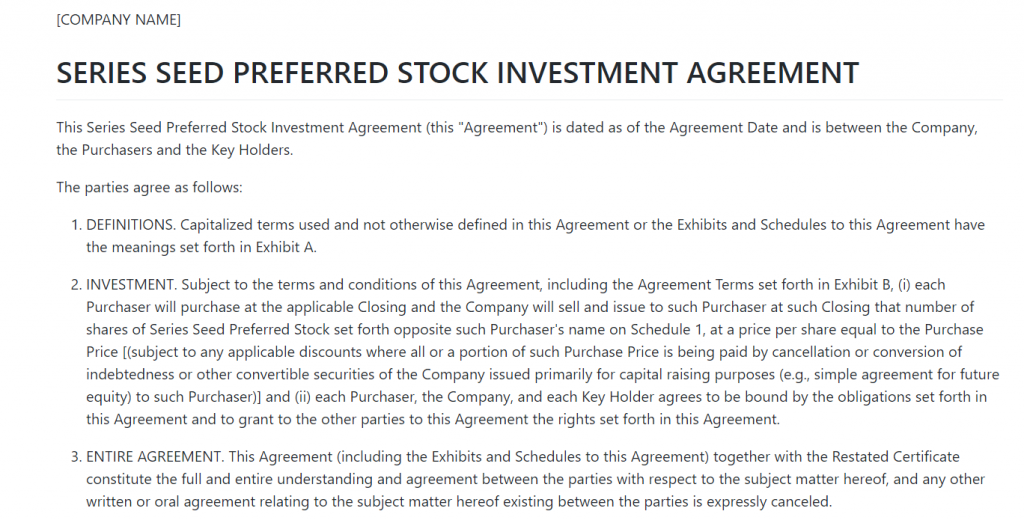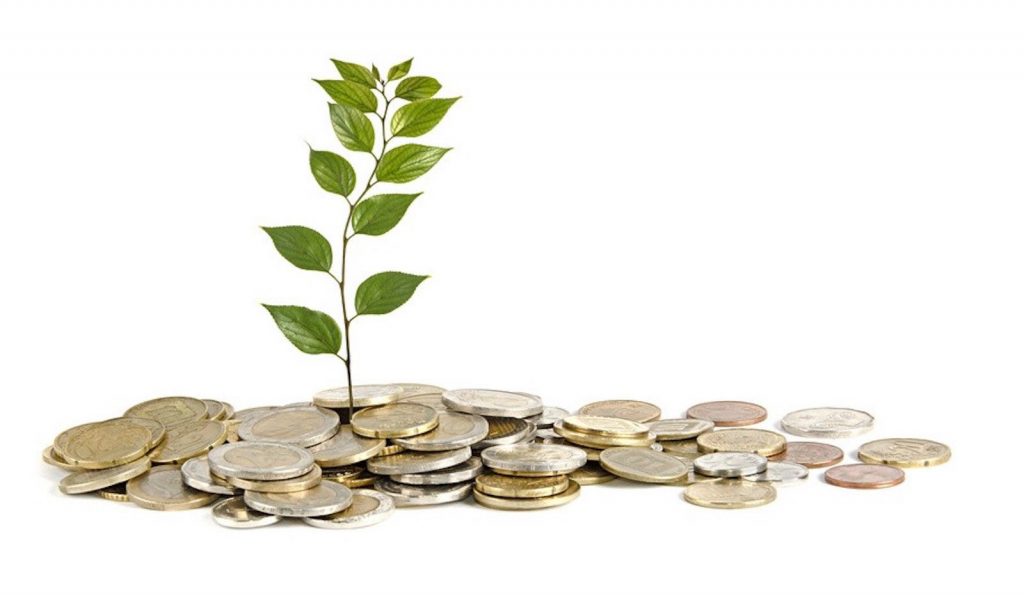Seed Stage Financing- SAFES VS Equity Rounds, Valuations, Tax Considerations, How Much to Raise
Entrepreneurs or startup company founders often need only modest amounts of capital in the early stages to cover expenses incidental to the business. Sometimes entrepreneurs cover the company’s early expenses through personal savings or even credit card debt. Many startups look to approach investors to get Seed-stage financing (initial capital investment in a startup company by an outside investor ) for the purpose of hiring more people, buying equipment, and further developing any product prototypes, etc.
Now while the definition of a seed investment will vary somewhat depending on whom you ask. It would not be unusual for someone to refer to larger friends and family financing as seed financing. The law firm CooleyGo explains that “the term seed financing usually denotes a company’s first round of financing from third-party investors who regularly invest in startup companies.”
A 3-time serial founder named Yin Wu published a recent article in Techcrunch where he stated “fundraising is a skill like any other. You get better the more you do it. But practicing gets you nowhere if you don’t have a strong foundation in understanding a fundraising round’s core components.”
My Wu also points out that as a founder, you will not have the upper hand over investors when it comes to fundraising, which seems pretty obvious. For investors, negotiating with founders is literally their full-time job. For startup founders, fundraising is just a small part of building a long-term and successful business. But learning and understanding the basics of venture financing can help founders raise on better terms for their company.
This article will cover a few topics around seed stage fundraising:
- How Seed financing works: comparing SAFEs versus Preferred Stock equity rounds
- Understanding the Goals of Various Types of Investors
- How much should you raise
- How to arrive at your startup’s valuation
- Tax Considerations
How Seed financing works: SAFE agreements VS equity financing rounds
Venture financing takes place in rounds. The first stage is the pre-seed or seed round, then a Series A, then a Series B, then a Series C, and so on. You can continue to raise funding until the company is profitable, gets acquired, or goes public.
We will focus here on seed-stage funding — your very first funding round.
SAFE Note Agreements
 (image credit: Feedough)
(image credit: Feedough)
In the Techcrunch article, Mr. Wu brings up a seed financing legal investing instrument known as a SAFE. You may be wondering what this is exactly? SAFE is an acronym that stands for “simple agreement for future equity” and was created by the leading Silicon Valley startup accelerator Y Combinator back in 2013 as a new financial instrument to simplify seed investment. At its core, a SAFE is a warrant to purchase stock in a future priced round. Y Combinator introduced this concept of SAFE as an alternative to convertible note that acted as a debt to the startups who were required to pay interest on it.
Mr Wu states that “post-money SAFEs are the most common way to raise funding. These documents are used by Y Combinator, angel investors and most early-stage funds. You should raise on post-money SAFEs using standard documents created by YC. Standard documents have consistent terms that have been drafted to be fair to both investors and founders.”
Basically, it’s an agreement in which an investor gives you money for your company now, with the expectation that you’ll convert that amount of money into shares of stock later on, usually at the next preferred stock financing round or a liquidation event. That means that SAFEs usually require much less paperwork and negotiation than issuing shares of stock right away. However, for many founders, it can still be overwhelming to understand how SAFEs work—especially when it comes to the differences between pre-money and post-money SAFEs.
A website called Feedough breaks it down into three key phrases;
- Investment contract: SAFE is not an equity or a debt. It is just a legal agreement where an investor invests in a startup in return for a right that they get to subscribe for new shares in the company in future upon the occurrence of certain events like – 1st equity financing (like a Series A), a liquidity event, or a dissolution event.
- Used to invest in early-stage startups: SAFE is used just to invest in early-stage startups when the valuation isn’t possible.
- In return for the rights to subscribe to new shares: Safe provides a safeguard for the early investors in the form of a right to subscribe for new shares in the future.
By using the standard post-money SAFE, your negotiation can focus on the two terms that matter:
- Principal: The amount you want to raise per investor.
- Valuation cap: The value of your business.
An alternative to post-money SAFEs is pre-money SAFEs. They were used until 2018 when post-money SAFEs were introduced. The difference between pre and post-money SAFEs is how they convert at the Series A funding round. This is not really something to worry about. What you should know is that the difference in dilution is minimal. However, one word of caution was raised by Andrew Krowne of Dolby Family Ventures in a TechCrunch article published in 2017 about SAFE note financing.
“We have observed that many founders don’t do the basic dilution math associated with what happens to their cap table (specifically their personal ownership stakes) when these notes actually convert into equity. By kicking the valuation can down the road, often multiple times, entrepreneurs end up owning less of their company’s equity than they thought they did. And when an equity round is inevitably priced, entrepreneurs don’t like the founder dilution numbers at all.”
So one takeaway is to make sure you understand that even if you have a discount, by foregoing a valuation cap at the seed stage, you could be diluting your shares and your future investors’ shares when you go to raise your Series A. If you want a deeper dive into the pros and cons of SAFEs and other Seed financing instruments check out this PDF from the law firm Fenwick & West LLP.
Equity Financing Round – Preferred Stock
 (image credit: Cooley/Github)
(image credit: Cooley/Github)
So you can think of a SAFE as an IOU for future equity. In contrast, an equity financing round occurs when you sell shares (aka equity). Beyond the financial terms of how much you want to raise and your company’s valuation, you also need to answer important questions around who controls your company through your board.
According to the Fenwick PDF document, there is also a set of Series Seed preferred stock documents that take into account various perspectives from the broader Silicon Valley community including venture capitalists and entrepreneurs.
There are two types of preferred stock documents used in seed financings: the lightweight www.seriesseed.com version and a full Series Seed set of documents.
These documents greatly simplify the transaction and defer the detailed negotiation of a fulsome set of investor rights until the Series A financing. Some of the most common provisions and key terms included in a traditional full Series A round, including:
- Liquidation preference
- Limited protective provisions (i.e., prohibiting the company from taking certain actions without the consent of the preferred stockholders; such actions may include changing rights of preferred stock, increasing authorized capitalization, creating senior series/class of preferred stock, redeeming stock (subject to customary exceptions), declaring dividends, changing board size, or selling or liquidating the company)
- Board seat
- Preemptive rights
- A drag-along (i.e., the ability to compel an investor to participate in certain sales)
The investors will receive the same rights as the future investors in the Series A financing. Importantly, The Fenwick Series Seed approach only requires two documents:
- Investment Agreement
- Certificate of Incorporation
No ancillary documents like a legal opinion and closing certificate are required, so the process is significantly streamlined and therefore less expensive than a full Series A round.
Although you may think of your company as “yours,” it is a separate legal entity. A company is controlled by stockholders who vote on a board of directors. This board of directors chooses a CEO and other leaders to manage the company — who may or may not be you. At equity financing rounds, investors who own a large percentage of your company can vote on the board and have greater control over the direction of your company.
If managing a board sounds complicated, it’s because it is. Raising funding via an equity round is always more complicated, expensive, and time-consuming than issuing a SAFE. The average pricing for an equity round is around $30,000-$50,000 and takes over a month. Raising on a SAFE is free and can close the same day because you can defer questions around control to the equity round.
Mr. Wu points out that “deals have momentum. Closing quickly means you can go back to focusing on building your business. Equity rounds can prolong your fundraising and are not recommended for the seed stage.”
Plan your fundraising before you start. You should be able to answer questions like, “How much dilution will I take if I raise $500,000 or $1 million? How do different valuations affect your ownership?”
You can plan your fundraising using a spreadsheet or a fundraising tool like Pulley. A spreadsheet is easy to get started and works for basic cases. A fundraising tool is better to accurately account for multiple investors with different terms, pro-rata, future equity rounds, and option pools.
Understanding the Goals of Various Types of Investors
A typical seed financing features a founding team (and perhaps up to a handful of employees) raising between $500,000 and $2 million to allow for 12 to 24 months of operational capital. During this time, the founders will attempt to prove out their idea and develop the traction required for raising the next round of financing (known as Series A financing) from a professional venture capitalist.
A seed investor’s purpose is typically to test their investment hypothesis (either on a founding team, idea, technology or market) by providing capital to a company that will test the hypothesis. Investors at this stage will often make a large number of small investments in a variety of companies on the theory that, while many of them will fail, the few that are successful will generate significant returns for the investor. At the seed stage, investors are deciding to make their investment primarily on their assessment of the quality of the founding team and the market opportunity presented by the business model. The prominent seed-stage investment firm First Round Capital explains that some of the things they look for in a founder or an idea come down to contrarian insights into how the world works. Such as “what do you understand about a market or a need that no one else does — that other companies in the space get wrong? And why is your company the most likely to win at addressing this gap? Second, if you already have a product in the market, a small group of passionate early customers is a strong indicator for us.”
The Fenwick PDF article points out that a few traits of founders that are seen as positive signals to investors include, but are not limited to:
- Technical/domain expertise in the planned business
- Prior successful entrepreneurial forays
- Strong introductions from people in their network
- Promising early traction
- Strong educational background (e.g., computer science engineers from Stanford or MIT etc)
To decide whether to invest in a seed round, an investor will likely meet with the founding team who will give the investor a pitch on their product/idea, market, team, and business model. Often the company’s existing contacts (e.g., advisors, former co-workers, or lawyers) set up these pitch meetings (known as a warm introduction).
How Much to Raise
 One of the first questions investors will ask you is how much you are raising. Funding rounds can be anywhere from $500,000 to more than $5 million. The amount you want to raise must be tied to a plan. This plan buys you credibility and persuades investors that you will be able to grow their capital.
One of the first questions investors will ask you is how much you are raising. Funding rounds can be anywhere from $500,000 to more than $5 million. The amount you want to raise must be tied to a plan. This plan buys you credibility and persuades investors that you will be able to grow their capital.
Mr. Wu’s TechCrunch article explains that “to create your plan, start with your goals and work backward.” If you’re building a software product, focus on building a hiring plan, because people will likely be the largest cost center. If you’re building a physical product or you’re in biotech, you’ll need to create a runway plan that includes your other significant expenses.
For your hiring plan, determine how many people you need to hire to build and sell your product. Can you get to your goals with two engineers in six months? Do you need five engineers and a sales team to prove people want your product? A rule of thumb at Y Combinator is that an engineer costs about $15,000/month. If you need 18 months of funding with five engineers, then you will need to raise at least 15,000 x 5 x 18 = $1.35 million. Add another 20% to this figure for operational costs like office rent.
Creating multiple hiring plans for different amounts of funding raised is a good idea. You want to give investors the impression that you will be successful regardless of whether you fundraise. If you raise $1 million, you can hire three engineers. If you raise $2 million, you can hire twice as many and build the product faster.
In choosing how much to raise you are trading off between dilution and capital. The more you raise, the longer you can put off your next fundraising round, but you’ll take greater dilution. If you can manage to give up as little as 10% of your company in your seed round, that’s great. Standard dilution at the seed stage is between 15%-20%. Avoid going over 25% dilution in the seed stage. You want to keep enough equity for future rounds to motivate employees in the future. First Round Capital states that their ideal ownership is roughly 15% after your seed round and that typically, their initial investment in a startup ranges from $750k to $4 million, but we’ve gone higher and lower in some cases. Currently, our average initial investment is right around $2 million.
How to determine how much your company is worth (Valuation)
- The simplest way to value an early-stage startup is through comps (looking at other early-stage startups), but businesses are unique, so accuracy is low
- Get additional inputs by working backward from how much cash you need and the ownership investors will ask for
- Beware of over-inflating your seed-stage valuation; hitting the required milestones could prove impossible for getting to the next round of funding (Series A)
Founders often want a concrete formula for determining their valuation. You want to know you’re not priced too low (taking unnecessary dilution) or priced too high (turning away investors). In practice, your valuation will come down to supply and demand. The more investors are interested in your business, the higher your valuation.
The reason a valuation at seed is so hard to determine is that there’s not much to value. Seed-stage rounds are investments when the company is laughably early. Often there are no metrics or customers. Even if you have some traction, valuation does not work as a formula where you get $1 million in additional valuation for every 1,000 customers on a waitlist.
Late-stage funding rounds, in contrast, are driven by metrics and profit margins. By the time of your Series B, founders are expected to have hit significant revenue and growth goals to prove their business works. At the seed stage, often there is no data to value businesses objectively.
What to do then? The practical advice is to research valuations for similarly staged businesses. TechCrunch announcements are a great source. If you have friends who are investors, talk to them and get a gut check on your company’s valuation. Depending on how many investors you will contact, you can also test your valuation live. If you’re finding that no investor is willing to write a check, you can lower the valuation on your next meeting.
The important thing is not to over-optimize your valuation. The objective is to find a valuation that will allow you to raise funding. When asked for your valuation, don’t hesitate. The market changes quickly and investors can be as unsure about your valuation as you are. Investors are taking a cue from you and your confidence in your ability to raise on those terms. An article in SVB explains that investors often turn to another method: they reverse engineer a startup’s post-money valuation based on the amount of cash a company is seeking and the ownership stake the investors need to warrant their time and money.
Jason Mendelson, a founding partner at the Foundry Group stated in the SVB article “I need an ownership stake big enough that I can justify to my investors taking a board seat and taking time on a company, So for example If the founders are asking for $4 million and he needs a 25% ownership stake to rationalize the investment, then everyone agrees that, on paper, the company is worth $16 million.”
“Remember that fundraising is not the goal. Building a successful business is. Don’t lose sight of the bigger picture!” – said Mr Wu, founder of Pulley.
Tax Considerations for Seed Stage Startups
All seed-stage startups, as well as any business that has received an EIN letter from the U.S. government, must file a tax return. Even if your letter arrives in December of 2021, you will still need to file a return for the year. If you have any business activity whatsoever, the IRS expects you to file, no matter how early the stage of your business.
Even if you lost money in 2020 or had $0 in profits, your startup should still file both federal and state returns for two reasons:
- You’re required by the government to file
- You will have the opportunity to benefit from your 2020 losses down the line. The current tax code allows businesses to use past losses to offset future taxes. So if you become profitable in the future, you can use your 2020 losses to offset some future tax liabilities in profitable years.
The Startup CPA Kruze Consulting points out in an article that if an acquiring company shows up in the future, one of the first questions you’ll be asked is, “Can you provide all of the company’s past tax returns?” Also if you go to raise a Series A or B funding rounding, It’s common practice for sophisticated, later-stage venture investors to ask for all past returns so they can make sure that your company has been legally compliant and operating properly. Your returns also provide a key window into the financials of your startup.
Due diligence will require a potential acquiring company to make sure you are compliant with all laws, including filing correct returns. Plus the content of your returns will provide key details into your startup. Not having all the necessary tax returns, or not having them done correctly could put a crimp in the acquisition process, and perhaps even halt it entirely. An acquirer’s due diligence red flag goes up when a startup’s financials don’t match its tax returns. The good news? This scenario can be entirely avoided by filing on-time correctly-prepared returns.
The bottom line is that whether you are a founder or an early employee at a startup, it’s important that you understand the tax implications of decisions you make today regarding how your company is structured, how and when you’re taxed on stock shares, and when you exercise stock options.
Conclusion
A First Round Capital partner wrote an insightful article that explains that it’s sometimes easy to get a Seed investment just based on your idea and team, but some startups make the mistake of underestimating what it will take as far as data and growth numbers to get a Series A term and investment check. Mr, Koplen writes “after raising a seed round, every startup should get smart about the inflection points they need to pass in growth, revenue, etc. to demonstrate the traction (customer acceptance, virality, revenue, engagement, etc.) they need to land a Series A. It’s more important than ever to hit those goals as Series A investors have more choices than ever to fill each general partners’ 1 to 3 investments a year.”
As you build out future plans, remember there’s no exact way to scale your business, but there are anecdotal stories and wisdom that can help you understand and weigh your options at each stage of your startup’s life cycle. I published an article titled a Startup Guide to Securing your VC Investor Funding is a compilation of both real-life fundraising tips and investor reporting requirements and expectations at each stage. Feel free to reach out to Huckabee CPA if you have any questions or for a free consultation.













